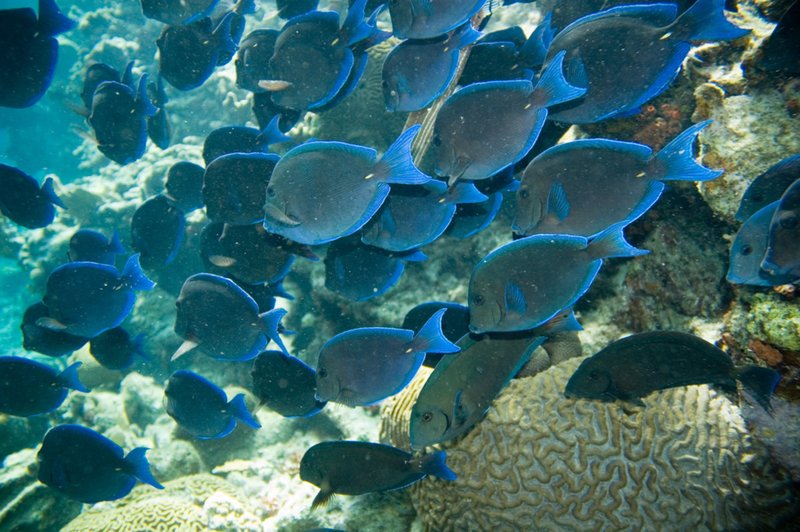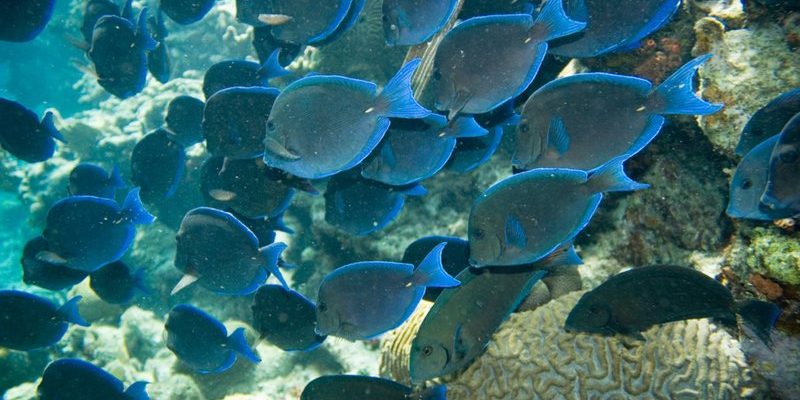
Imagine you’re hosting a tiny party in your aquarium. You want to make sure your guests (in this case, your fish) are happy, healthy, and have everything they need to thrive. Caring for a Blue Tang involves more than just throwing them into the tank and hoping for the best. From the right water conditions to a balanced diet, let’s dive into everything you need to know to keep your Blue Tang healthy and joyful in your saltwater aquarium.
Setting Up the Perfect Aquarium Environment
Creating the right environment for your Blue Tang starts with choosing the right aquarium size. Ideally, you want at least a 75-gallon tank. I know that sounds like a lot, but these fish need room to swim and explore. Think of it like giving them a spacious home rather than a cramped apartment. If you have a bigger tank, that’s even better!
Next, consider the water quality. Blue Tangs thrive in stable salinity, with a specific gravity between 1.020 and 1.025. A reliable saltwater hydrometer will help you keep track of this. Water temperature should be maintained between 75°F and 82°F. Regular testing is vital, so invest in a good testing kit to check for ammonia, nitrite, and nitrate levels. High levels of these can stress your fish and lead to health issues.
Finally, don’t forget about filtration and aeration. A high-quality protein skimmer will remove waste and help maintain water quality. Adding live rock and some hiding spots made from reef-safe materials also gives your Blue Tang places to explore and feel secure. Just remember to clean the tank regularly and perform monthly water changes, about 10 to 15% of the tank volume to keep everything in balance.
Choosing the Right Tank Mates
When setting up your saltwater aquarium, the choice of tank mates can be just as crucial as the Blue Tang itself. You’ll want to avoid aggressive species that might nip at your tang or stress it out. Think of this as creating a community; everyone should get along and have their own space.
Good tank mates for a Blue Tang include clownfish, wrasse, and gobies. These species typically coexist well and won’t compete much for food. On the other hand, you should steer clear of species like lionfish or other tangs, as they might not play nicely.
It’s also a good idea to introduce new fish gradually. If you just dropped in a new tank mate, your Blue Tang might feel territorial. Adding them one at a time can help ease the transition. Watching them interact can be delightful, turning your aquarium into a lively environment where each fish adds its flair!
Feeding Your Blue Tang
Feeding a Blue Tang is more than just tossing in some flakes. These fish are primarily herbivores, so they thrive on a diet rich in greens. Think of it like making sure they get their daily dose of salad! You can provide them with marine algae, spirulina flakes, or nori. The latter is often available in sheets; just attach it to a feeding clip so your Blue Tang can munch away.
Additionally, you can supplement their diet with frozen or freeze-dried foods that contain a mix of brine shrimp and other protein sources. Oddly enough, even though they love greens, it’s crucial to mix it up to keep their diet balanced. It’s similar to how we would eat a variety of foods to get all the nutrients we need.
Don’t forget that Blue Tangs can sometimes be picky eaters. If you notice your fish starting to refuse food, don’t panic—try changing up their diet or offering different types of greens. And as a bonus tip: feeding them small amounts a few times a day can help keep them happy and healthy.
Understanding Blue Tang Behavior
Every fish has its quirks, and Blue Tangs are no exception. You might notice them swimming around energetically or engaging in some playful chases—this is perfectly normal! Let’s imagine them as the athletes in your aquarium; they need their space to show off their skills.
However, if your Blue Tang starts hiding more than usual or becomes less active, that could be a sign of stress or illness. It might be worth checking the water parameters or looking for signs of illness, like white spots or frayed fins. Just like you would watch for changes in a friend’s mood, keeping an eye on your fish’s behavior can tell you a lot about their health.
Besides, Blue Tangs are susceptible to ich, a common parasite. If you suspect your fish is unwell, consider using a quarantine tank to keep the sick fish separate while you treat them. This helps prevent spreading illness to your other fish.
Routine Maintenance for a Healthy Aquarium
You might be wondering, “What’s my part in keeping this underwater world thriving?” Regular maintenance is key to ensuring that your Blue Tang and its mates live happy, healthy lives.
Start with your water changes. As I mentioned earlier, performing monthly water changes helps keep chemical levels balanced. It’s kind of like a reset button for your aquarium. You’ll want to use a siphon to remove debris from the bottom and replace it with fresh, treated saltwater. This will help minimize harmful toxins and keep the ecosystem running smoothly.
Next, keep an eye on your filtration system. It’s important to regularly clean your filters to prevent them from getting clogged. A clean filter means cleaner water, which is essential for the health of your Blue Tang.
Lastly, don’t forget to do a little maintenance on decorations and equipment, too. Algae can build up on surfaces—so don’t be afraid to scrub those rocks and glass. Just be gentle, as you don’t want to disturb your Blue Tang’s home too much.
Recognizing and Addressing Common Problems
No one wants to see their beloved Blue Tang unwell, but knowing some common problems can make a big difference. As a responsible fish owner, it’s crucial to stay observant and be proactive.
One common issue is ich, which I mentioned earlier. This is often recognized by small white spots appearing on your fish’s body. If you spot these, treatment is essential. Quarantine the affected fish and use a medicated treatment designed for ich. Remember, treating the entire tank can sometimes be necessary, too, since ich can spread quickly.
Another concern is poor water quality. If your Blue Tang seems lethargic or is hiding a lot, it could be a sign that something’s off. Testing your water regularly is vital to catch any spikes in ammonia, nitrite, or nitrate levels early.
And let’s not forget about fin rot, which can occur due to stress or poor water quality. You might notice frayed edges on your Blue Tang’s fins. If this happens, ensure the water conditions are optimal and consider adding a stress coat to support healing.
Caring for a Blue Tang in your saltwater aquarium can be an incredibly rewarding experience. It’s like creating your own little underwater wonderland, complete with vibrant colors and lively personalities. By providing a spacious environment, the right tank mates, and a balanced diet, you’re not just setting the stage for a beautiful aquarium—you’re ensuring a healthy, happy life for your Blue Tang.
So, whether you’re a seasoned aquarist or just dipping your toes into the world of saltwater keeping, remember that every fish deserves love and attention. With a bit of knowledge and care, your Blue Tang can thrive, turning your aquarium into a stunning centerpiece in your home. Happy fish-keeping!

